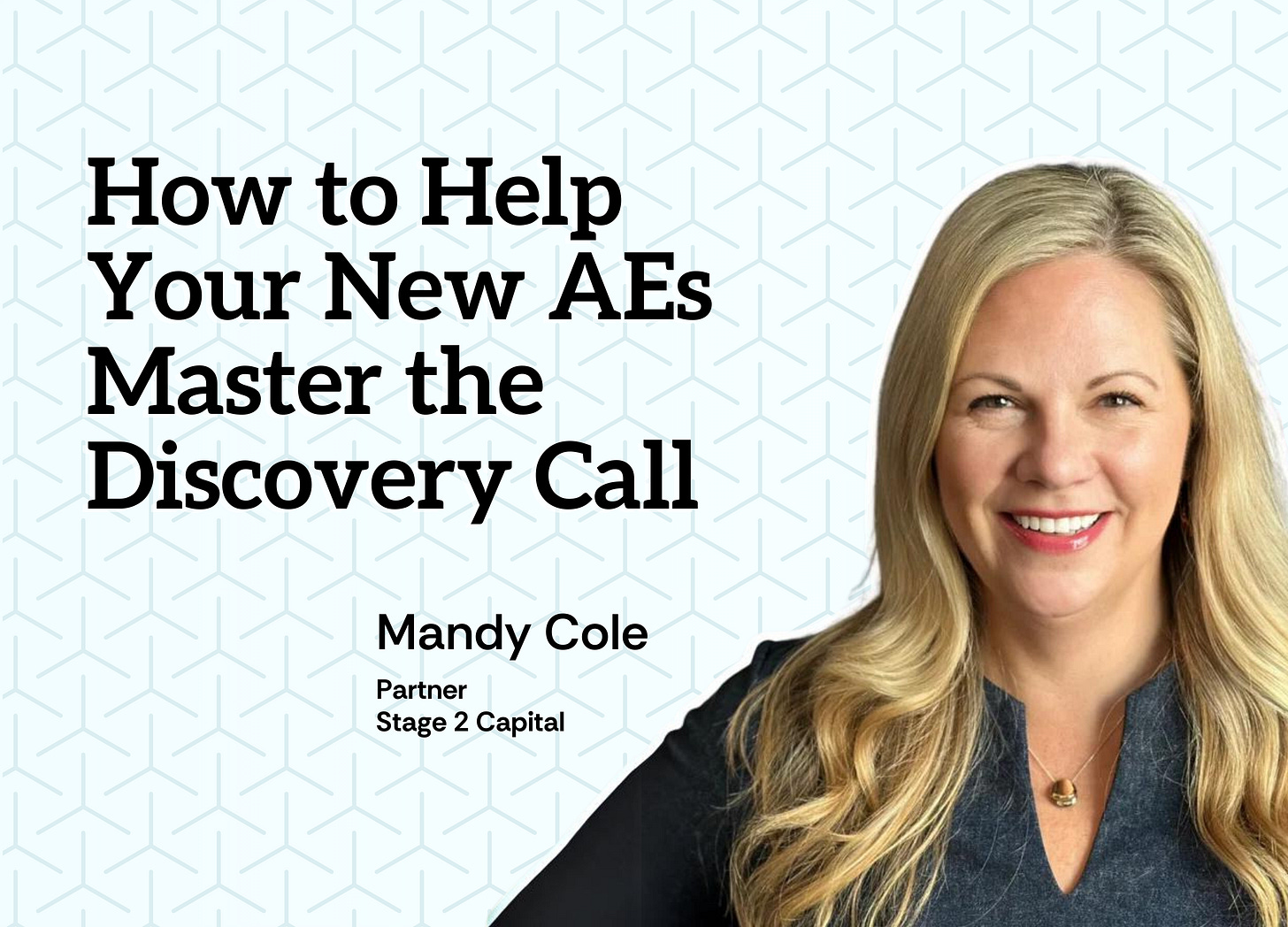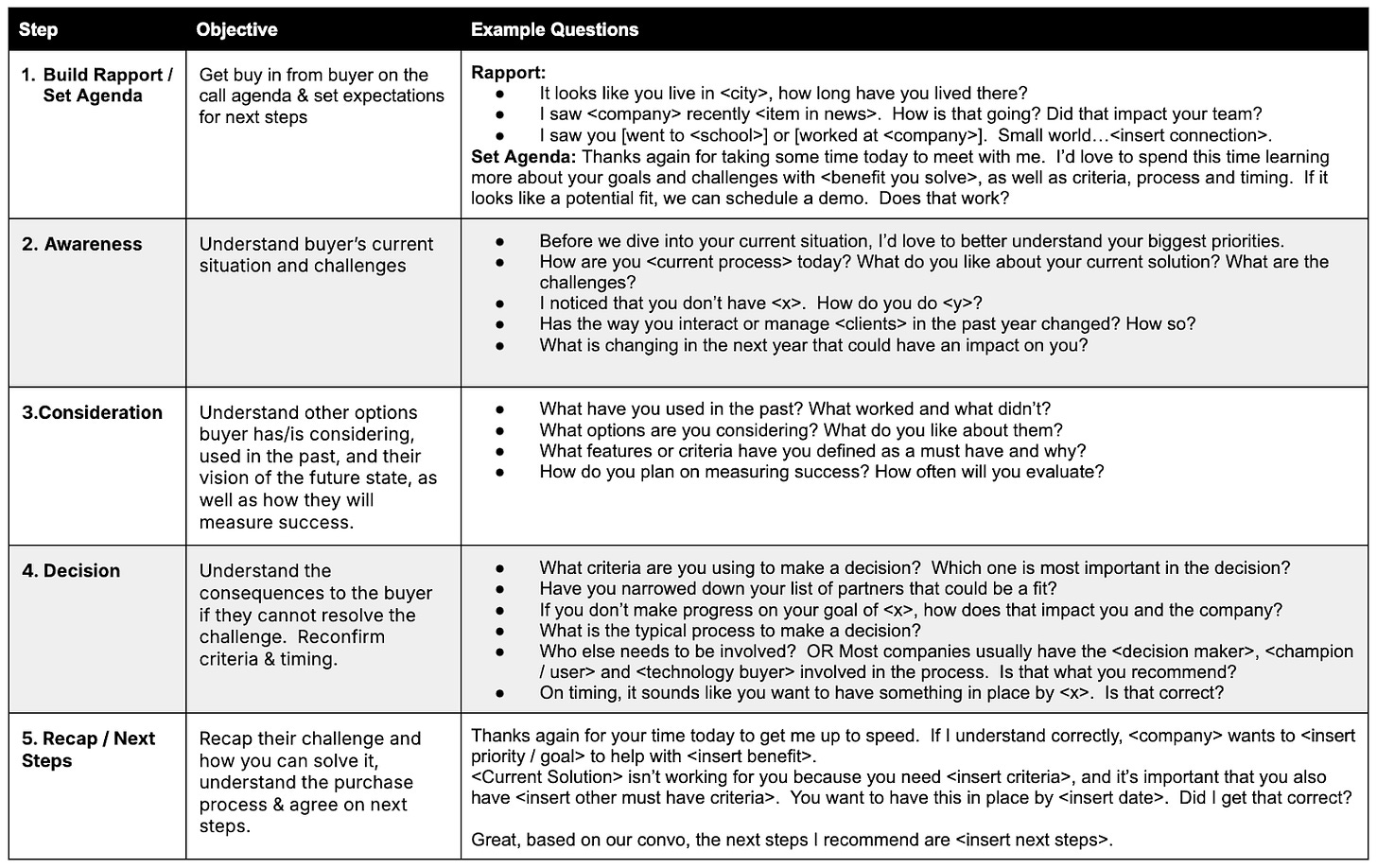How to Help Your New AEs Master the Discovery Call
Turn your new AEs into discovery call pros with the right prep, practice, and guidance.
DEAR STAGE 2: We're ramping up our first two AEs and trying to transfer the institutional knowledge we've gained from months of selling as founders. The most challenging step seems to be the initial discovery call - specifically, probing for information while maintaining a natural conversation flow. How can we help our team succeed? ~XYZ
DEAR XYZ: Easy! You need to document, practice and coach. Easier said than done, but these steps aren’t actually difficult, they just take real time and effort. My Partner, Mandy Cole, has distilled years of sales management and leadership experience into an incredible set of resources around building your GTM playbook, with a great section dedicated to the discovery call.
Let's start with documentation. You need to take the time to observe your own calls (I encourage you to listen to a few and try to view them as a seller new to your company, product, and buyers would). And here's the good news - you don't have to do this manually anymore. AI-powered conversation intelligence tools like Momentum, a Stage 2 Portfolio company, or Gong can automatically extract key insights without you having to sift through hours of call recordings. What are you assuming is a given that's actually important to communicate and teach? Generally, this starts with documenting the goals and challenges of each buyer persona, as well as their unique needs during the buying process. With this as backdrop, here's some advice for running a great discovery call that you can adapt to your environment:
1. Set the agenda in advance
When preparing for a Discovery Call that includes multiple personas, you need to establish a clear agenda. One effective strategy is to send an agenda email prior to the call. Recap previous discussions, highlight identified challenges, and outline the goals of the upcoming call.
For example:
Subject: Recap and Agenda for Our Upcoming CallBody: “Hi Team, it was great speaking with [Initial Contact] last time. Here are the key challenges we discussed and the goals we hope to achieve in our next conversation. I’d love to hear if there are any additional points you’d like to ensure we cover.”
By proactively sharing this information with all participants, you foster transparency and prepare everyone for a more effective discussion.
2. Engaging multiple perspectives on the call
Take the time to acknowledge each participant individually. Begin with a brief recap of the previous discussion and then invite input from the new attendees. This approach not only makes everyone feel valued but also helps to surface any additional challenges or perspectives that might not have been previously considered.
3. Stay organized
Keep the agenda in mind, and ensure that discussions don’t veer off into unrelated areas. By guiding the dialogue and making sure each persona has a chance to contribute, you can create a balanced discussion that addresses the needs of all stakeholders.
4. Follow up—fast
Immediately after the call, send out a summary email that highlights key points discussed, decisions made, and next steps. This reinforces clarity among all participants and keeps everyone aligned as you move forward in the sales process.
Securing follow-up calls with potential buyers can often be a challenge due to their busy schedules. Know your champion; this is the person who advocates for your solution within the organization. You’ll also need to identify other key decision-makers who should join subsequent calls.
5. Establish a clear cadence
When scheduling follow-up calls, define a structured cadence. Instead of trying to cover everything in one call, consider spreading discussions over multiple sessions:
Discovery call: Establish challenges and gather insights from the primary contact.
First demo call: Tailor this session based on the insights gathered, ensuring to highlight specific use cases that resonate with the buyers’ pain points.
Follow-up calls: Schedule additional sessions to address specific concerns or involve other key stakeholders as necessary.
This approach not only breaks down the information into digestible parts but also keeps the buyers engaged and invested in the process.
Once you’ve done this work, it’s time to start practicing and coaching. You’ve likely had hundreds, maybe thousands of calls with your buyer and intimately understand the nuances of your solution. Role play with your team and ride along on their discovery calls to ensure you are giving real time feedback that helps them get better every day!
If you’re ready to dive in on documenting what’s working for you, here’s Mandy’s cheat sheet to get you started. You can also grab our discovery guide template here:
Until next week!




